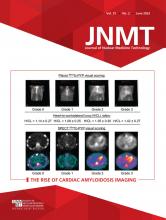It’s finally June! A time when the nuclear medicine community from around the world comes together to share scientific research, technical advances, and the latest clinical applications in nuclear medicine and molecular imaging. This year, the SNMMI’s Annual Meeting will be held in the windy city – Chicago, Illinois. This four-day event will present state-of-the-art educational programs, networking opportunities with peers and industry partners, and special programs and interactive gatherings to round out each day. For those unable to attend in person, a virtual option will provide access to the many educational opportunities offered during the meeting.
The SNMMI’s Annual Meeting also allows the Technologist Section to highlight its accomplishments, announce the 2023–2024 elections winners, and present multiple awards, including the JNMT Best Paper Awards. The JNMT Best Paper Awards spotlight the best-published manuscripts from the previous year written by technologists as the first author in the following categories: Scientific Papers (1st, 2nd, and 3rd place), Continuing Education, and Educators’ Forum. You can find a complete JNMT 2022 Best Paper Awardees list on the SNMMI website (https://www.snmmi.org/AboutSNMMI/Content.aspx?ItemNumber=43091). I ask this question each year, “Is your name on that list?” If not, why not? Consider sharing your expertise in an educational article, an unusual teaching case study, or a clinical research study from your institution. Don’t know how to get started? Help is available! Visit the JNMT website at https://tech.snmjournals.org/authors for general information, or better yet, contact me directly so that I can pair you with a mentor that can help you get published!
Kathy S. Thomas, MHA, CNMT, PET, FSNMMI-TS
This special issue of JNMT presents a comprehensive discussion of an ‘old/new’ cardiac technique that is energizing the nuclear cardiology community today. Mary Beth Farrell, EdD, CNMT, FSNMMI-TS, JNMT’s CE editor and ‘star player’ in the creation and development of this content, explains:
“Over the past 20 years, nuclear cardiology has felt stagnant. The PET or theranostic communities have developed all the cool new stuff. But wait! A new kid in town – 99mTc -pyrophosphate (PYP) imaging – is restoring nuclear cardiology to its former prominence.
Wait one minute. Hot PYP imaging isn’t new. It’s been around since the 1970s. So how can 99mTc-PYP be considered new-fangled, and for that matter, how could it possibly reinvigorate nuclear cardiology? Well, nuclear cardiology has taught an old dog new tricks.
99mTc-PYP is now being used to diagnose cardiac amyloidosis, a disease previously considered rare, undiagnosable, and incurable. Thankfully, a lot has happened over the past five to ten years to challenge these misconceptions. 99mTc-PYP imaging and advancements in echocardiography and cardiac magnetic resonance have identified an unknown prevalence of the disease. Cardiac amyloidosis is now recognized as a significant cause of heart failure, a condition affecting over 5 million patients in the United States. Along with advances in detection, new treatments for cardiac amyloidosis are available.
Thus, the renewed interest in 99mTc-PYP imaging means technologists should reacquaint themselves with the procedure. Unfortunately, although 99mTc-PYP imaging seems relatively simple, there are several ways to screw up the scan producing inaccurate results. Therefore, this issue of the JNMT takes an in-depth look at 99mTc-PYP imaging for cardiac amyloidosis.
Anchoring the issue are three continuing education articles written by the team of Monica Embry-Dierson, Mary Beth Farrell, Eric Schockling, Dr. Scott Jerome, and Jaime Warren. Part 1 provides a detailed look at the etiology and characteristics of cardiac amyloidosis, including the types, prevalence, signs and symptoms, and disease course (1). Part 1 also details the acquisition protocol. Part 2 provides a little color by describing the history of 99mTc-PYP imaging and then describes image processing and quantification (2). Finally, Part 3 reviews cardiac amyloidosis clinical characteristics, scan interpretation, diagnosis, and treatment (3).
To complement the three continuing education articles, there is a cardiac amyloidosis Practical Protocol Tip (4). A helpful article by Jaime Warren discusses radiopharmaceutical alternatives such as 99mTc-DPD and 99mTc-HMDP, along with necessary protocol modifications in case of another pyrophosphate shortage (5). In addition, Drs. Mrinali Shetty and Saurabh Malhotra look at novel tracers destined to play a role in cardiac amyloidosis, including antimyosin scintigraphy, sympathetic innervation imaging, and amyloid-specific probes (6).
A case study series by Drs. Saurabh Malhotra and John Stroger combined all the pieces by illustrating positive transthyretin and light chain cardiac amyloidosis scans. Another case in the series emphasizes the importance of technique by demonstrating a potential false positive scan due to blood pool activity (7). Finally, Dr. Bharadwaj Satyavolu, Dr. Prem Soman, and Joseph Deitz sum everything up by reviewing the impact of 99mTc-PYP scintigraphy on the field and detailing its strengths and weaknesses (8).”
As reading time is available, don’t miss the additional scientific manuscripts covering an assortment of topics and teaching case studies pinpointing a specific diagnosis to round out this issue’s content.
As mentioned in previous editorials, and now has become my ‘broken record’ message, the JNMT is a peer-reviewed publication that needs your help! Each manuscript published in the JNMT undergoes an important peer-review process that is only as good as the volunteers willing to share their expertise by becoming reviewers for manuscripts that fall within their area of interest. We have a growing number of dedicated technologist reviewers; however, we still need more! If you are interested in becoming a JNMT reviewer, please visit the JNMT manuscript submission website (https://submit-jnm-snmjournals.org/) or contact me (ksthomas0412{at}msn.com. And for those considering becoming a reviewer but as a novice who feels that additional information would be helpful, a continuing education webinar titled ‘Tips and Guidelines for JNMT Reviewers’ is available. So please help us to build and maintain the quality of JNMT by becoming a JNMT reviewer.








